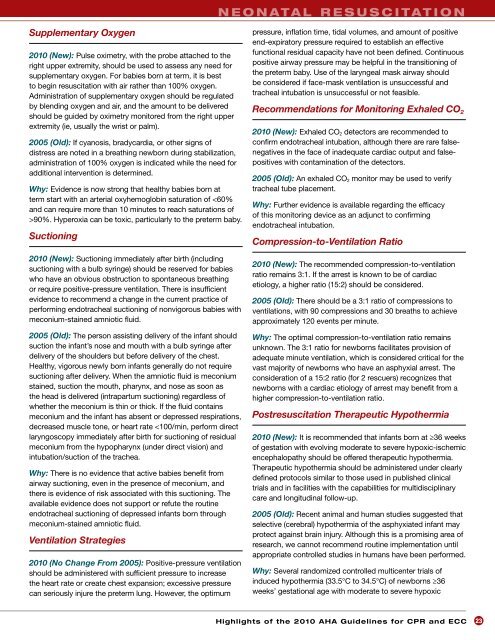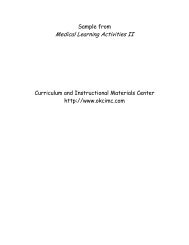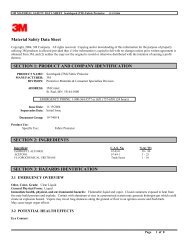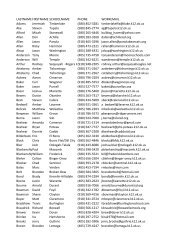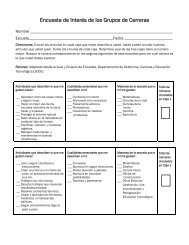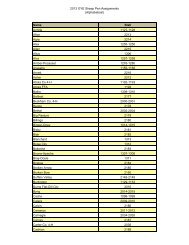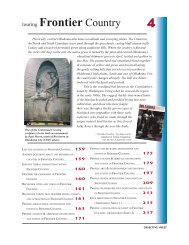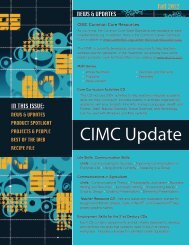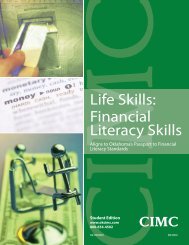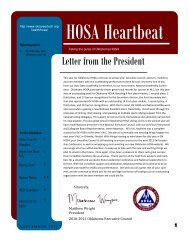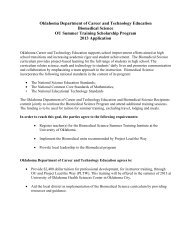Highlights of the 2010 Guidelines for CPR and ECC - ECC Guidelines
Highlights of the 2010 Guidelines for CPR and ECC - ECC Guidelines
Highlights of the 2010 Guidelines for CPR and ECC - ECC Guidelines
Create successful ePaper yourself
Turn your PDF publications into a flip-book with our unique Google optimized e-Paper software.
n e o n a t a l r e s u s c i t a t i o n<br />
Supplementary Oxygen<br />
<strong>2010</strong> (New): Pulse oximetry, with <strong>the</strong> probe attached to <strong>the</strong><br />
right upper extremity, should be used to assess any need <strong>for</strong><br />
supplementary oxygen. For babies born at term, it is best<br />
to begin resuscitation with air ra<strong>the</strong>r than 100% oxygen.<br />
Administration <strong>of</strong> supplementary oxygen should be regulated<br />
by blending oxygen <strong>and</strong> air, <strong>and</strong> <strong>the</strong> amount to be delivered<br />
should be guided by oximetry monitored from <strong>the</strong> right upper<br />
extremity (ie, usually <strong>the</strong> wrist or palm).<br />
2005 (Old): If cyanosis, bradycardia, or o<strong>the</strong>r signs <strong>of</strong><br />
distress are noted in a breathing newborn during stabilization,<br />
administration <strong>of</strong> 100% oxygen is indicated while <strong>the</strong> need <strong>for</strong><br />
additional intervention is determined.<br />
Why: Evidence is now strong that healthy babies born at<br />
term start with an arterial oxyhemoglobin saturation <strong>of</strong> 90%. Hyperoxia can be toxic, particularly to <strong>the</strong> preterm baby.<br />
Suctioning<br />
<strong>2010</strong> (New): Suctioning immediately after birth (including<br />
suctioning with a bulb syringe) should be reserved <strong>for</strong> babies<br />
who have an obvious obstruction to spontaneous breathing<br />
or require positive-pressure ventilation. There is insufficient<br />
evidence to recommend a change in <strong>the</strong> current practice <strong>of</strong><br />
per<strong>for</strong>ming endotracheal suctioning <strong>of</strong> nonvigorous babies with<br />
meconium-stained amniotic fluid.<br />
2005 (Old): The person assisting delivery <strong>of</strong> <strong>the</strong> infant should<br />
suction <strong>the</strong> infant’s nose <strong>and</strong> mouth with a bulb syringe after<br />
delivery <strong>of</strong> <strong>the</strong> shoulders but be<strong>for</strong>e delivery <strong>of</strong> <strong>the</strong> chest.<br />
Healthy, vigorous newly born infants generally do not require<br />
suctioning after delivery. When <strong>the</strong> amniotic fluid is meconium<br />
stained, suction <strong>the</strong> mouth, pharynx, <strong>and</strong> nose as soon as<br />
<strong>the</strong> head is delivered (intrapartum suctioning) regardless <strong>of</strong><br />
whe<strong>the</strong>r <strong>the</strong> meconium is thin or thick. If <strong>the</strong> fluid contains<br />
meconium <strong>and</strong> <strong>the</strong> infant has absent or depressed respirations,<br />
decreased muscle tone, or heart rate


